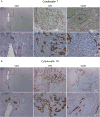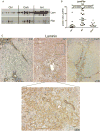Progenitor cell expansion and impaired hepatocyte regeneration in explanted livers from alcoholic hepatitis
- PMID: 25731872
- PMCID: PMC4558407
- DOI: 10.1136/gutjnl-2014-308410
Progenitor cell expansion and impaired hepatocyte regeneration in explanted livers from alcoholic hepatitis
Abstract
Objective: In alcoholic hepatitis (AH), development of targeted therapies is crucial and requires improved knowledge of cellular and molecular drivers in liver dysfunction. The unique opportunity of using explanted livers from patients with AH having undergone salvage liver transplantation allowed to perform more in-depth molecular translational studies.
Design: We studied liver explants from patients with AH submitted to salvage transplantation (n=16), from patients with alcoholic cirrhosis without AH (n=12) and fragments of normal livers (n=16). Hepatic cytokine content was quantified. Hepatocyte function and proliferation and the presence of hepatic progenitor cells (HPCs) were evaluated by immunohistochemistry, western blot or quantitative PCR. Mitochondrial morphology was evaluated by electron microscopy.
Results: Livers from patients with AH showed decreased cytokine levels involved in liver regeneration (tumour necrosis factor α and interleukin-6), as well as a virtual absence of markers of hepatocyte proliferation compared with alcoholic cirrhosis and normal livers. Electron microscopy revealed obvious mitochondrial abnormalities in AH hepatocytes. Importantly, livers from patients with AH showed substantial accumulation of HPCs that, unexpectedly, differentiate only into biliary cells. AH livers predominantly express laminin (extracellular matrix protein favouring cholangiocyte differentiation); consequently, HPC expansion is inefficient at yielding mature hepatocytes.
Conclusions: AH not responding to medical therapy is associated with lack of expression of cytokines involved in liver regeneration and profound mitochondrial damage along with lack of proliferative hepatocytes. Expansion of HPCs is inefficient to yield mature hepatocytes. Manoeuvres aimed at promoting differentiation of HPCs into mature hepatocytes should be tested in AH.
Keywords: ALCOHOLIC LIVER DISEASE; CYTOKERATINS; EXTRACELLULAR MATRIX; HEPATOCYTE; LIVER REGENERATION.
Published by the BMJ Publishing Group Limited. For permission to use (where not already granted under a licence) please go to http://www.bmj.com/company/products-services/rights-and-licensing/
Conflict of interest statement
Figures







Comment in
-
Stimulating hepatocyte renewal: a new paradigm for the treatment of severe alcoholic hepatitis unresponsive to corticosteroids?Gut. 2015 Dec;64(12):1839-40. doi: 10.1136/gutjnl-2015-309545. Epub 2015 Apr 3. Gut. 2015. PMID: 25841240 No abstract available.
References
-
- Lucey MR, Mathurin P, Morgan TR. Alcoholic hepatitis. N Engl J Med. 2009;360:2758–69. - PubMed
-
- Naveau S, Chollet-Martin S, Dharancy S, et al. A double-blind randomized controlled trial of infliximab associated with prednisolone in acute alcoholic hepatitis. Hepatology. 2004;39:1390–7. - PubMed
-
- Louvet A, Naveau S, Abdelnour M, et al. The Lille model: a new tool for therapeutic strategy in patients with severe alcoholic hepatitis treated with steroids. Hepatology. 2007;45:1348–54. - PubMed
Publication types
MeSH terms
Substances
Grants and funding
LinkOut - more resources
Full Text Sources
Other Literature Sources
Medical
